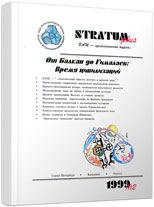Древние цивилизации Востока и степные племена в свете данных археологии
Bronze age civilizations of Central Asia and archaeology of the Eurasian steppes
Author(s): Vadim M. MassonSubject(s): History, Archaeology, Cultural history, Economic history
Published by: Издательский дом Stratum, Университет «Высшая антропологическая школа»
Summary/Abstract: The archaeological discoveries of the last decades present the new data for study the interactions between the Central Asian urban civilizations and the pastoral societies of the Eurasian steppes. From the archaeological reconstruction we seen some phenomena. The first this is the intensive activity in the first half of II mill. B. C. in the region of Southern Ural and the Middle Volga in many aspects: the technology, cultural progress and social life. Oval forteresses like Arkaim (fig. 1) in the Soutern Ural attest both to the military conflicts and to a centrelised organisation of the society. Burials of noblemen (chariotry) are beeng found (Sintashta, Utevca and others — fig. 2, 3). Political development takes a miliyery-aristocratic course. The second phenomenon this is the movement of the steppe tribes southwards where they replaced the local hunters-fichers population and come in active contacts with urban civilizations in South Turcmenistan (Namazga VI, Margiana sities) and Middle AmuDarya (Sappaly, Dashly). The burial with horse bits of Sintashta type have been founded in Samarkand region (fig. 4) also as the settelments with typical steppe bronze age pottery (fig. 6). This movement has been continued during the whole second millenium B.C., most active in the second last half of this millenium. The third phenomenon this is the cultural syntesis traits typical for the local urban civilizations and the traditins of the steppe pastoral tribes. We seen the gradual migration of the steppe tribes who mixed with local population (sybiosis cultures like the Bishkent culture in the western Tadjicistan). As the results of the such interactions we found in the Central Asian sites swastic motifs (fig. 5) and the horse representations (fig. 7, 8). It was by new ethnic unities came into being linked for the most parts with Indo-Iranian lingvistic.
Journal: Stratum plus. Археология и культурная антропология
- Issue Year: 1999
- Issue No: 2
- Page Range: 265-285
- Page Count: 21
- Language: Russian

